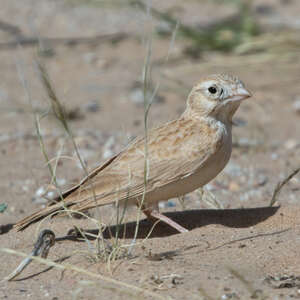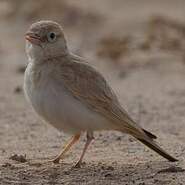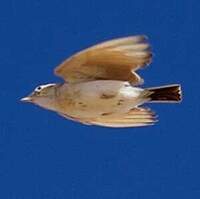Dunn's Lark
Eremalauda dunni - Alouette de Dunn
Identification
Dunn's Lark is a sandy-coloured lark living in desert areas. It looks similar to an Ammomanes species but is always easily recognizable. It is about medium size, smaller than A. Élégante and bigger than A. Isabelline, with a relatively compact body and short tail.
The upperparts, mantle and wings, are sandy blond, clearly striped and mottled with light reddish brown. The underparts are off-white with a pinkish tinge in the chest area. The sides of the neck, slightly mottled, hint at the beginning of a breast band, which may cause confusion with a Calandrella species.
The very long tertials are the same colour as the body, and the black-ish tips of the external primaries create a short, but visible Projection primary at the back. The median rectrices are light reddish brown, hiding the others, which are blackish-brown and have sandy edges.
The head is quite large and shows the same colours as the body: the crown is striped, the dark eye is circled by a white ring along a light eyebrow, which is then joined by a dark line below the eye, and this line then joins a dark border of the auricular coverts. In front, at the level of the lores, a dark arc, which may look blackish depending on the angle of view, is visible at the contact of the pale circle. The front of the lores is pale. There is a very faint moustachial stripe. All this creates a typical head pattern. From the front, the head appears bulbous, especially when the wind lifts the auricular coverts. The pale beak, ranging from pink to bright red, is quite wide and curved.The culmen, straight at the base first, curves to the front. It is from 3/4 in front that the height of the beak is best distinguished. There are individual variations in the size of the beak, probably related to sex, and the bulky element may not be obvious.
The legs are rosy or yellowish, with a short hind claw.
The juvenile is distinguished from the adult by the upper feathers edged with dark and then pale, but very discreetly, so at a distance it does not seem different from the adult.
In flight, for example when the territorial male sings, the bird's appearance is typical from below. The wide pale wings, translucent in the sun, contrast sharply with the short all-black tail. Against a very bright background, one might get the impression that the bird has no tail.
The Arabian subspecies eremodites is more typical than the type subspecies. The head pattern is more marked, with a clear malar line this time, the bill is bulkier and the upper parts are more visibly streaked.
Subspecific information monotypic species
Foreign names
- Alouette de Dunn,
- Alondra de Dunn,
- calhandra-eremita,
- Einödlerche,
- nomádpacsirta,
- Dunns Leeuwerik,
- Allodola di Dunn,
- saharalärka,
- Nomadelerke,
- škovránok saharský,
- skřivánek bledý,
- Eremitlærke,
- arabianaavikkokiuru,
- alosa de Dunn,
- Melalævirki,
- skowrończyk grubodzioby,
- Danna cīrulis,
- peščeni škrjanec,
- Малый вьюрковый жаворонок,
- ウロコスナヒバリ,
- 图氏沙百灵,
- saharalärka,
- 杜恩氏沙百靈,
Voice song and call
The song is emitted from the ground, a small bush more rarely, but especially in territorial flight where it is more sustained and louder. It consists of a babble reminiscent of Calandra's, alternating with long iiiiiih of high pitch and drawn out, lower and somewhat plaintive diuuuu. The high iiiiih have a certain kinship with those of the elegant Ammomanes song which sound like a creaky swing. The syllables just of Elegant are less pure, a bit screeching and modulated. But confusion is easy.
Both species are often in sympatry, which may explain this.
Habitat
Dunn's Lark is a desert species, but it is always looking for green areas that have received minimal rainfall, thus having a natural vagabond temperament given the irregular rainfall in desert areas.
Behaviour character trait
Dunn's Lark is a gregarious species like most larks for the most part of the year. It wanders in small mobile groups depending on resources, themselves dependent on the weather conditions.
Hence, its presence in a precise location is unpredictable without having knowledge of these conditions. When these conditions are favorable, after abundant rainfall, the groups break up into territorial reproducing couples which divide up the terrain in the best way possible, with a high population density in the most favorable places.Its plumage color makes it a homochromatic bird with its desert environment, thus making it difficult to spot from the ground. Fortunately, it has the good habit of seating on and in the vicinity of roads. However, when nestled and singing, it is easy to spot due to its particular song. It is not skittish and can be approached quite easily. Alertly, it observes, head raised, beak pointing towards the sky.
Flight
The typical flight pattern of a Dunn's Lark, alternating between flapping and pauses. The wide, curved wings enable the singing males to perform their slow, territorial flight quite high in the air. At the end of this flight, they drop like stones towards the ground, their wings slowing the fall at the last moment.
Dietfeeding habits
Reproduction nesting
Reproduction is dependent on the rainfall regime, which varies from year to year and from region to region.
It closely follows a rainy season; usually it takes place after the winter or spring rains, but sometimes as early as October. Couples nest either singly or in loose colonies, depending on the environment. The nest, made of grass and vegetable fibers, is on the ground, in a dug-out depression at the foot of a herbaceous clump or shrub. The clutch consists of 3-4 eggs. A reproductive cycle lasts three weeks from the laying to the emancipation of the young, which is very short. This is probably an adaptation to the fluctuating environment. In favorable years, it allows pairs to raise two successive broods.Geographic range
The subspecies Dunn's Lark dunni is sub-Saharan. It has a discontinuous Sahelian band that extends from Mauritania and the Western Sahara (southern Morocco) to Sudan.
The subspecies eremodites occupies the Arabian peninsula to southern Syria, with a centre of gravity in Saudi Arabia.
The species is considered to be sedentary in the major regions, but has strong erraticism within them due to the spatial and temporal irregularity of the rain regime.
Threats - protection
IUCN conservation status
concern
in the Wild
threatened
evaluated
Due to its life history and remote environments occupied, the exact status of Dunn's Lark is not well known. It is generally considered to be uncommon and patchy in its fragmented range, but can also be locally common. Though its populations are likely to be fluctuating, it is not currently considered to be threatened.
Sources of information
- IOC World Bird List (v15.1), Gill, F and D Donsker (Eds). 2025-12-07.
- An Atlas of the Birds of the Western Palearctic, Colin Harrison
- Guide encyclopédique des oiseaux du Paléarctique Occidental, BEAMAN Mark
- Avibase, Lepage Denis
- HBW Alive,
- xeno-canto, Sharing bird sounds from around the world,
Other sources of interest
 Specification sheet created on
27/07/2023 by Jean François
Specification sheet created on
27/07/2023 by Jean FrançoisTranslation by AI Oiseaux.net
© 1996-2025 Oiseaux.net
- Accipitriformes
- Aegotheliformes
- Anseriformes
- Apodiformes
- Apterygiformes
- Bucerotiformes
- Caprimulgiformes
- Cariamiformes
- Casuariiformes
- Charadriiformes
- Ciconiiformes
- Coliiformes
- Columbiformes
- Coraciiformes
- Cuculiformes
- Eurypygiformes
- Falconiformes
- Galliformes
- Gaviiformes
- Gruiformes
- Leptosomiformes
- Mesitornithiformes
- Musophagiformes
- Nyctibiiformes
- Opisthocomiformes
- Otidiformes
- Passeriformes
- Pelecaniformes
- Phaethontiformes
- Phoenicopteriformes
- Piciformes
- Podargiformes
- Podicipediformes
- Procellariiformes
- Psittaciformes
- Pterocliformes
- Rheiformes
- Sphenisciformes
- Steatornithiformes
- Strigiformes
- Struthioniformes
- Suliformes
- Tinamiformes
- Trogoniformes


















